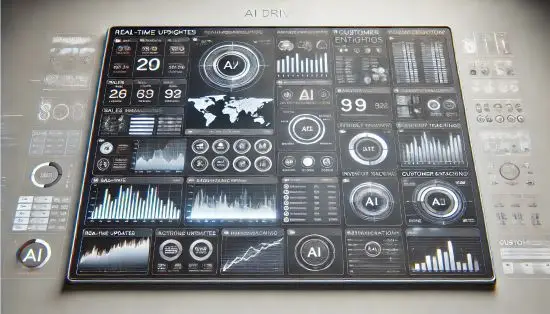
Empowering Businesses with AI: A Beginner’s Guide
Running a business—whether it’s a cozy retail shop or a bustling service company—comes with its fair share of challenges. The to-do list feels never-ending, whether it’s keeping up with customer demands, managing inventory, or staying competitive in an ever-changing market. The good news is that technology is here to lend a helping hand. Artificial Intelligence (AI) may sound futuristic, but today, it’s a practical tool that is changing the game for businesses of all sizes.
At its core, AI refers to technology that can harness data to make smarter, more informed decisions. Think of it as a helpful assistant working behind the scenes to streamline your day-to-day operations. And the best part? You don’t need to be a tech wizard to start using AI. Businesses across industries—particularly in retail and services —are already seeing results. This guide will simplify how AI can help empower your business through practical examples and real-life data.
Let’s break it down.
AI’s Impact on Retail and Services: By the Numbers
As AI continues to evolve, its effect on the retail and service industries is becoming undeniable. Whether you’re managing products on shelves or providing a personalized customer experience, AI is quietly (yet powerfully) transforming the business landscape. Let’s take a look at some of the key numbers.
AI in Retail Growth: The global AI retail market is set to reach a staggering $23 billion by 2026, thanks to its ability to enhance everything from inventory management to customer service. [Source: MarketsandMarkets ]
Personalized Customer Experiences: Around 75% of businesses report that AI helps them provide better, more personalized customer interactions. AI tailors recommendations and services based on individual preferences, which can significantly enhance the customer experience. [Source: McKinsey ]
Cost Savings from AI Chatbots: By 2025, businesses are expected to save a whopping $11 billion using AI chatbots, automating routine inquiries and allowing employees to focus on more meaningful, human interactions. [Source: Juniper Research ]
AI isn’t a passing trend; it’s a strategic move already making a measurable impact.
Real-World AI Use-Cases in Retail and Services
With all the buzz around AI, how are businesses using it in their day-to-day operations? Here are some practical examples from the retail and service sectors that show how AI is making everything more accessible.
AI-Powered Chatbots: Always-On Customer Service
If you’ve ever messaged an online store and received an instant reply from a helpful “agent,” chances are, you were talking to an AI chatbot. These bots can answer questions, recommend products, and even help with orders—any time of the day.
Take Sephora, for example, which uses chatbots to guide customers through product selections, educate them about beauty trends, and even schedule appointments. AI chatbots are a lifesaver for small businesses, allowing them to offer top-tier customer service without hiring additional staff. Companies like Zendesk provide chatbot solutions that are easy to implement and manage.
AI for Smarter Inventory Management
For businesses that sell physical products, efficiently managing inventory is critical. AI can help predict demand, track stock levels, and even reduce waste from overstocking. Walmart, for instance, uses AI-driven tools to analyze vast amounts of sales data to optimize its supply chain.
Smaller businesses aren’t left out either. Tools like Zoho Inventory allow business owners to manage stock more precisely, reducing costs and ensuring that popular products are always available.
Dynamic Pricing: Smarter, Real-Time Price Adjustments
Have you ever noticed how prices on e-commerce sites seem to change frequently? That’s AI-driven dynamic pricing at work. Companies like Amazon use AI to analyze competitor pricing, sales trends, and demand to adjust prices in real time.
For smaller businesses, AI-powered pricing tools like Prisync enable a similar competitive edge, even on a smaller scale. The technology helps businesses spot market patterns and respond quickly with price adjustments, maximizing their profits while staying competitive.
Personalized Recommendations: A Tailor-Made Experience
You’ve likely experienced this before: You browse an online store, and immediately, the site starts suggesting products that seem tailored just for you. That’s AI-powered personalization in action. Retailers like Macy’s use AI to offer personalized recommendations based on browsing history, past purchases, and customer preferences.
This technology isn’t exclusive to big brands. Smaller businesses can also harness AI to craft more personalized customer experiences using tools like HubSpot. This tool helps businesses send personalized content and product recommendations to customers based on data insights.
Navigating AI’s Ethical and Cultural Impacts
While AI offers businesses plenty of competitive advantages, it’s important to acknowledge some of its potential challenges, especially when it comes to ethics and diversity in AI’s adoption.
Ethical AI: Ensuring Fairness and Protecting Privacy
One of the key concerns around AI is whether decisions made by algorithms are always fair. AI, after all, is dependent on the data it’s fed. If AI systems are trained on biased or incomplete datasets, they might make unfair assumptions about certain customer segments, leading to AI bias. For example, using historical sales data to recommend products might skew in favour of certain demographics while ignoring others.
Businesses must ensure their AI tools are transparent and unbiased to foster trust in AI. Some providers, like IBM Watson, are beginning to offer more ethical AI solutions designed to prioritize fairness and ensure the decision-making process is explainable.
AI for Both Large and Small Businesses: Bridging the Gap
Another aspect to consider is whether smaller businesses can truly leverage AI in the same way as big corporations. Larger organizations, with their significant resources, may have access to custom AI solutions, while smaller teams may feel left behind.
However, the boom in AI-as-a-service platforms, like Google AI and Azure AI, is helping level the playing field. These platforms provide ready-made AI tools that are customizable and affordable, making them suitable for small and medium-sized businesses. With the right approach, even small businesses can start small, using one or two AI solutions to reap significant long-term benefits.
Global Adoption: How AI Use Differs Around the World
AI is not being adopted at the same rate globally. North America and Western Europe have led the way in AI integration due to the availability of resources and more mature infrastructure. Meanwhile, regions in Asia and Latin America are seeing growing AI investment but still face challenges around data privacy laws and smaller budgets.
In regions like the European Union, privacy laws such as GDPR restrict data collection, requiring businesses to be mindful about how they gather and process consumer data. If your company serves customers across different locations, understanding regional privacy laws will help you avoid legal setbacks while maintaining consumer trust.
The Human Side of AI: Striking the Right Balance
As helpful as AI is, it’s essential to remember that people are still at the heart of every business. AI can help streamline certain tasks, speed up processes, and make personalized recommendations, but it’s not there to replace the power of human connection.
In customer service, for example, AI chatbots may provide quick responses, but a human touch is still irreplaceable for more complex issues or when empathy is needed. The goal is for AI to complement human work —taking care of the repetitive tasks so your team can focus on what truly matters: building stronger customer relationships.
Wrapping Up: Embrace AI Gradually
AI may seem like a giant, intimidating leap—but businesses are adopting it incrementally, starting small and scaling up. Whether you bring in a chatbot to handle customer inquiries or tap into AI-powered analytics to customize your marketing, the key is introducing AI tools at your own pace.
At the end of the day, AI presents opportunities for businesses of all sizes to operate smarter, improve customer connections, and thrive in competitive markets. There’s no rush to do everything overnight; start with what makes sense, observe the benefits, and build from there.
Technology can be a game-changer, and AI is opening doors to a future where businesses can be more efficient and competitive without sacrificing the personal touch your customers love.


